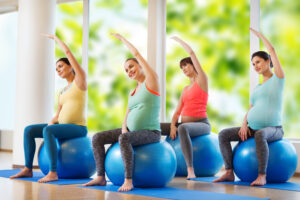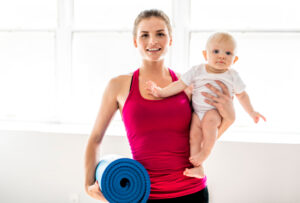Many expectant mothers are confused about the what, where and how of exercise during pregnancy. It is important to remember that pregnancy is a normal condition and not an illness. Thus for most woman, it is possible to stay active and continue their sport or activity through the majority of their pregnancy. There are many benefits to exercising during pregnancy, and in fact, the current Australian current guidelines recommend it!
A woman’s body is undergoing constant mechanical, physiological and emotional changes throughout her pregnancy. The most obvious change is weight gain (average 10-15kg), which leads the centre of gravity to be shifted forward. This can affect balance and putting strain onto the back and pelvis. It is for this reason that care should be taken with any challenging balance or agility type exercise during pregnancy.
 A pregnant woman will experience an increase in resting heart rate (HR), and also a decrease in maximal heart rate. It is important to not use your previous maximal HR as a guide for exertion. The intensity of exercise can be monitored by the mother’s rating of perceived exertion eg You know you’re at a good exercise intensity when you can talk normally (but cannot sing) and do not become exhausted too quickly.
A pregnant woman will experience an increase in resting heart rate (HR), and also a decrease in maximal heart rate. It is important to not use your previous maximal HR as a guide for exertion. The intensity of exercise can be monitored by the mother’s rating of perceived exertion eg You know you’re at a good exercise intensity when you can talk normally (but cannot sing) and do not become exhausted too quickly.
A hormone called relaxin is released during pregnancy, which causes increased laxity of ligaments, especially around the pelvis. As one can imagine, this is very important in preparing for childbirth
When it comes to exercise, care should be taken when changing direction (agility exercise) and excessive stretching during activity. Strengthening exercises (particularly core strength exercises) may also decrease the potential of injury to these joints.
During the second trimester of pregnancy, the development of blood vessels to supply the growing placenta will cause blood pressure to fall. From approximately the fourth month, pregnant women should avoid rapid changes of position, both from lying to standing and vice-versa, so as not to experience dizzy spells. Leg exercises done whilst lying on the back should be avoided after the fourth month as the weight of the foetus can slow down the return of blood to the heart. Try to modify these exercises as most can be done lying on the side. Prolonged periods of motionless standing should also be avoided.
As pregnancy progresses, the body’s ability to transport oxygen improves. This is known as our V02 Max. This adaptation is designed to meet the needs of the growing foetus. This means that oxygen supply to other parts of the body, including working muscles, also improves. These cardiorespiratory adaptations are potentially advantageous for performance after the baby is born. During pregnancy, the advantages are offset by changes in weight, blood pressure and ligaments, and by the need to ensure oxygen supply to the foetus. Post Birth this window for improved performance generally goes unnoticed due to changes in sleep habits, breastfeeding and stress of managing a newborn.
There are no studies to date that show an association between exercise and adverse outcomes for the foetus. There are however some areas where concerns have been raised:
- Birth Weight
- Most studies have not shown any significant difference in babies’ birth weights for exercising and non-exercising pregnant women.
- However, one recent study showed women who exercised intensely more than three times per week in their third trimester delivered significantly smaller babies.
- It is therefore recommended that exercise in the third trimester be limited to three sessions or less and not be as intense as earlier in the pregnancy
- Contact sports
- There has been much theoretical concern about the risks to the foetus whilst participating in ‘contact’ sports such as netball.
- There is currently no research to support this concern.
- The current advice is that each woman should discuss her wishes with her doctor and take into consideration the type of sport, pregnancy status and her history of participation in that sport
- Over-heating
- Some animal studies have indicated that over-heating of the mother in the first trimester may cause an increased risk of neural tube defects.
- It is reasonable to suggest that it is not wise to exercise in the heat of the day and to stay well hydrated when exercising
 In general, healthy women who have uncomplicated pregnancies can continue their previous exercise program after consultation with their doctor. It is also now considered safe to START an exercise program. No studies have determined a safe ‘upper’ limit of exercise but as pregnancy continues, increased size and fatigue generally cause most women to lessen their participation.
In general, healthy women who have uncomplicated pregnancies can continue their previous exercise program after consultation with their doctor. It is also now considered safe to START an exercise program. No studies have determined a safe ‘upper’ limit of exercise but as pregnancy continues, increased size and fatigue generally cause most women to lessen their participation.
The current guidelines recommend approximately 30 minutes of moderate intensity exercise on most days of the week. By the third trimester, no more than three sessions per week of vigorous exercise are advised.
Activities to avoid during pregnancy are:
- Contact sports and activities, or those with a high chance of falling
- Heavy weights and lots of high-stress abdominal exercises are best to avoid during this time as these exercise place a huge amount of unnecessary stress on the body
- Jumping exercises, especially later in the pregnancy, as it places increased stress on the pelvic floor muscles, which are already under a lot of stress.
- Lying on your back for prolonged periods of time, especially after the first trimester. An alternative can be using an incline bench or Swiss ball.
- Extreme high temperatures, for example, Bikram yoga

Suggested exercises may include:
- Walking
- swimming and aqua aerobics
- Pilates
- stationary cycling
- strength training with low weights and medium-high repetitions
- Yoga
- jogging or running – if this was already an activity prior to pregnancy and should be discontinued during the 2nd and 3rd trimester due to the impact on the pelvic floor and the pelvis.
Exercise should be stopped if any abnormal symptoms occur such as
- Pain
- Contractions
- Vaginal bleeding
- Dizziness/faintness
- Unusual shortness of breath
- Back or pelvic pain
- Decreased foetal movements
- Sudden swelling of ankles, hands and face
When it comes to exercising throughout your pregnancy, listen to your body -If something doesn’t feel right, stop and seek advice. Remember to stay hydrated and keep calorie intake up especially if exercising over a prolonged period of time. Always ensure adequate sleep and rest and avoid exercising in high heat and humidity. If doing a class, always alert the instructor to the fact you are pregnant. And, most importantly, be flexible and adaptable to change in training programs and expectations – we want you to stay active throughout your pregnancy so don’t feel disheartened if your plans change.
For more information call the centre on 52515724 or email Catherine at catherine@bellareinesmc.com.au
